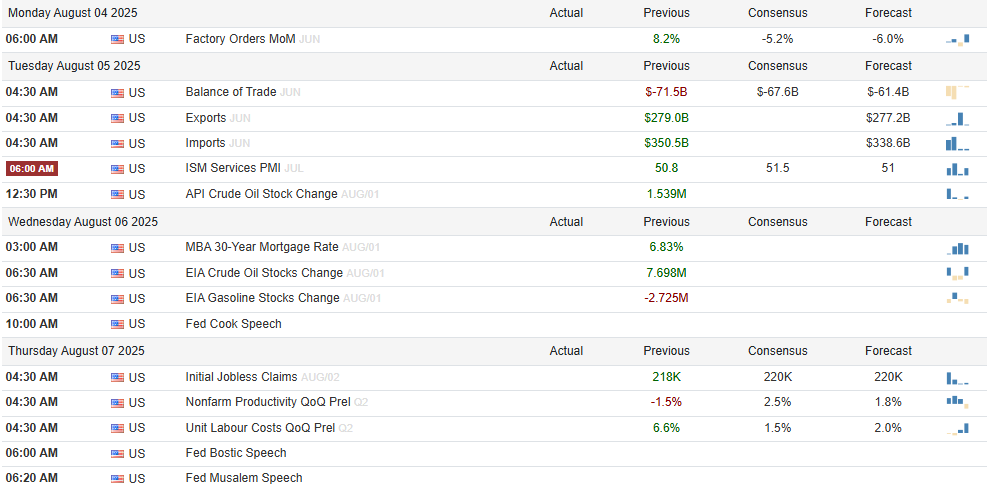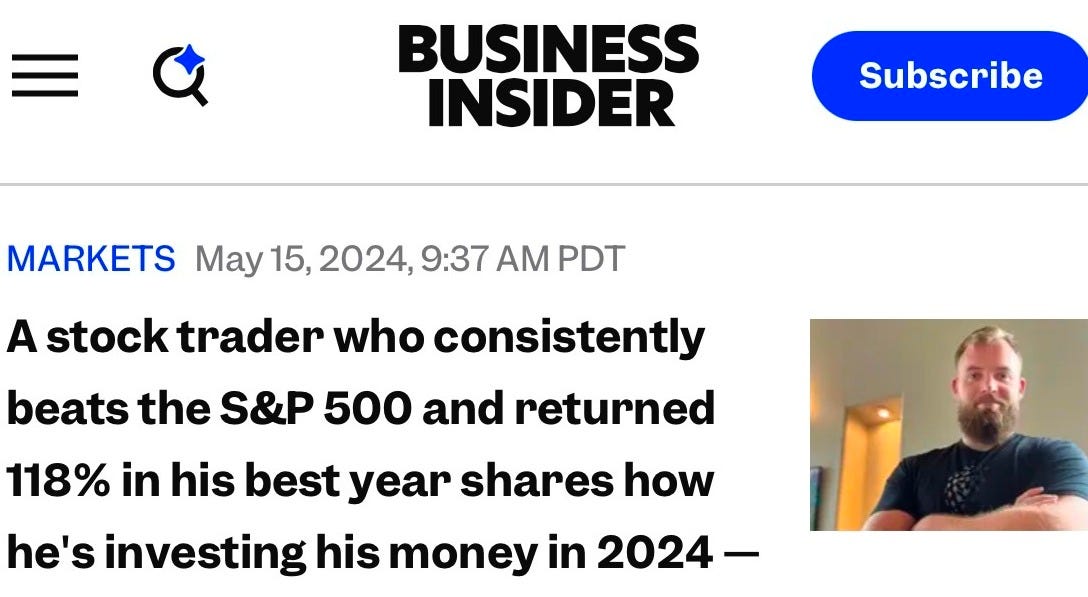main effort strategy | Outlier Insights
Welcome to Outlier Insights!
Each week I work hard to gather and curate information for your convenience. There are two main topics to the newsletter:
Market Analysis is where I share 15 high summary points for the market from the week prior.
Erik’s Brainstorming is where I share a couple ideas to watch each week along with my perspectives; often market related, sometimes not.
If what I do helps you out, please consider either subscribing on Substack or joining the Patreon to support my work and join the Outlier Community! You can also simply share the content, which is a big help as well.
Be an Outlier!
-Erik
Announcements
Outlier Community Updates:
Outlier Pros can check out the weekly schedule of events below, with streams set for Sunday (Market Prep), Tuesday (Market Internals), and Thursday (Skill Development). https://www.patreon.com/posts
The next Outlier Pro Plus Zoom workshop is 4Aug at 5pm PT! We work through live market analysis and trade building scenarios. For those interested in joining at the promotional rate, it will end once I finalize the format, which will be soon. https://www.patreon.com/OutlierTrading
Links.
Outlier Trading YouTube Channel - Daily livestreams & Weekly videos every Sunday.
FREE Outlier Community - Join like minded traders, education, & information.
Outlier Pro Patreon - Ready to transform your trading? Build for options traders of ANY skill level.
1. Market Analysis.
S&P 500 Performance: The S&P 500 gained 1.50%, closing at a record 6,388.64, driven by strong Q2 earnings and trade deal optimism, marking its fifth straight week of gains.
Nasdaq Composite: The Nasdaq rose 1.19%, ending at 21,108.32, achieving its 15th record close of 2025, though tempered by mixed tech earnings.
Russell 2000: Small-cap stocks in the Russell 2000 advanced 0.85%, trailing large-caps but showing resilience with broader market participation.
Sector Leaders: Health Care surged 3.33%, followed by Industrials (+2.18%) and Materials (+2.15%), fueled by robust earnings and manufacturing data.
Sector Laggard: Consumer Staples fell 0.08%, the only negative sector, reflecting cautious consumer spending signals.
Tech Sector Dynamics: Communication Services jumped 2.44% on Alphabet’s AI-driven gains, while Information Technology rose 0.90%, weighed down by Intel’s weak earnings.
Consumer Discretionary: The sector gained 1.26%, but Tesla’s significant revenue drop limited stronger advances.
Trade Developments: New U.S. trade agreements with Japan (tariffs reduced to 15%), Indonesia, and the Philippines boosted market sentiment, with China talks ongoing.
Economic Indicators: Initial jobless claims dropped to 217,000, signaling a robust labor market, while July PMIs showed strong services activity offsetting manufacturing weakness.
Volatility Trends: The VIX fell from 16.75 to 14.93, indicating reduced market fear and growing investor confidence.
Market Breadth: S&P 500 breadth improved, with 66% of stocks above their 200-day moving averages, up from 60.92%, reflecting a broadening rally.
Commodities: Oil prices dropped 3.12%, and gold slipped 0.34%, influenced by global bond yield shifts and trade uncertainties.
Global Markets: European stocks rose as the ECB held rates steady and EU trade talks progressed; the U.S. dollar weakened amid positive trade news.
Earnings Highlights: 83% of S&P 500 companies beat Q2 earnings estimates, with 8.5% year-over-year growth, though mega-cap strength masked weaker broader gains.
Market Outlook: Despite tariff concerns and a softer jobs report, positive trade developments and earnings support cautious optimism for continued equity strength.
Economic Events for Next Week.
Looking to make serious progress as a trader without the BS? Join the Outlier community to accelerate your learning curve and develop your trading skillset. What members say:
““I’ve spent thousands on courses and alerts over the years, but nothing ever clicked like this. Erik rewired how I think. For the first time, I understand volatility, risk, and why trades work. I’m finally trading with confidence instead of guessing.”
-James K.
2. Erik’s Brainstorming.
This post turned into an absolute bear. For those not interested in all the verbose backdrop, skip to section two (2/3 bottom).
Tl:Dr; focusing on building core strategy(ies) vs bouncing all around is far more efficient. Basing the core strategy(ies) on robust market effects provides a solid starting point for new traders.
In the military, we clearly delineate different roles by assigning main and supporting efforts. The main effort is our primary bid for success. The supporting efforts are designed to position the main effort to be successful.
Much of what I do includes adaptations from my time in the military because it proves really valuable frameworks for thinking. In this post, I want to discuss two things:
Setting healthy starting points to generate returns
Developing a main effort strategy. For those not interested in the verbose backdrop, skip to this.
Starting with an orientation of trader expectations. Most of us begin hoping to make fast easy money. That’s natural. However, like the normal maturing process in life, we need to grow out of it if we want trading to actually work long-term.
Trading in general is a skilled activity. Options trading adds a deep layer of complexity. This complexity lies on a spectrum tied to the objectives of the trader.
We can trade short calls against shares to collect some premium, pretty basic. This also isn’t going to drastically outperform the market. Same for trading the wheel. Basic enough that when paired with good stock selection, it can work well within context. While not linear, there is a relationship between difficulty and outcome.
For those looking to trade as a profession, it’s a bit further on the spectrum and this is who I’m talking to. I’m in my 19th year of trading and it forms the backbone of my financials.
If you think you’re the next rain man and will be massively scaling within 3 years - it could be true, but is unlikely. For most of us, it’s a longer roadmap and I’ll explain why.
Trading will hit across three broad buckets. Fundamental knowledge, process, and behavior. We can rapidly accelerate our fundamental knowledge by focused study.
I think a fair comparison is a 4 year degree(ish) level of material. That can be completed more quickly if taken seriously enough.
The trick, is there is no real accelerator for practical experience besides - experience. This naturally takes longer. We can be efficient, but we cannot fast forward time.
I would strongly consider the first 3-5 years as an investment into yourself and your skills. That’s not to see you won’t see any return in that time, ideally you will. But that isn’t the main effort.
The initial priority is learning and building experience. Just as when you earn an undergrad, you willingly invest the time, earning minimal income and building debt, with the expectation of greater upside.
Yet traders want to grow their 5k account 100x in 24 months. Those 90%+ trader failure stats makes a lot of sense doesn’t it?
In my opinion, spending the first few years deeply understanding market operations, equity behavior, option fundamentals, and building a main effort strategy to begin is wise - while aggressively saving. I think a fair target for the first two years of trading is greater than 0%.
For brand new traders, you will likely need to bounce around between different market effects you want to monetize to create a short list of the concepts that instinctually make sense. We should also continually experiment, but will need to pivot the majority of our focus on researching and developing a main effort strategy.
During this period you are able to efficiently build out your knowledge, trading processes, and behavior (which includes experience).
Part 2.
How do we build a main effort strategy (mes)? I chose to begin with well documented market effects that I could monetize, I call these profit mechanisms.
Well documented market effects don’t always provide insane returns, but they’re real, they’re consistent, and for someone with no experience - a fantastic starting point.
While it’s completely cool to test different things and explore, I think most of the effort should be directed towards the mes. I created a 4 step process for strategy development:
Profit mechanism scoping (research market effects that can be monetized)
Profit mechanism analysis (quantify and qualify the PM. Attach signals)
Structure overlay (test base trade structures that capture the effect to measure which is optimal for my intended use case)
Strategy development (refine the optimal structure(s) into defined plans which include (4) pieces: executive summary, set up, management, and after action review
To develop a main effort strategy, I chose to start with easily defined things since I had no idea wtf I was doing. I began with market beta as the base - buy and hold of an index/sector etf.
With beta as my baseline, I began exploring methods to enhance the returns. Tons of easily accessible data and robust. Other ideas include momentum factors, risk premiums I think are a little less beginner friendly (they favor more scale), etc.
After completing steps 1-3 I identified two ways I wanted to trade them, ratio diagonals and covered strangles. While capital intensive I actually think the covered strangle is a great starting point because it takes the base effect of what most of us otherwise would do, buy and hold (or DCAing) and amplifies it slightly. This can be taken a step further to include double dipping into long box spreads with capital set aside for the CSP side of the trade. Another step can include trading levered ETFs via momentum following.
While these kinds of ideas aren’t going to drive the 50%+ annual returns people want, they do provide real returns that build experience while growing your capital (which should be paired with aggressive savings). In parallel, testing other profit mechanisms and strategies leads to a really efficient process.
A simple test to determine when it’s suitable to spend more time on other strategies over the mes is answering:
Do I feel completely confident I know exactly how I will manage my mes in all market conditions?
Am I confident my current plan is optimal given my preferences?
Do I know with a high confidence interval, what my returns will look like (+&-)?
If the answer is no to any of these, more time is needed on your main effort strategy.
Trading is the hardest easy money you’ll find. All of the work up front is an investment because it absolutely gets much easier as you build your approach. Good luck out there.
Be an Outlier
Erik
DISCLAIMER:
The content presented is for informational purposes only and any opinions, news, research, analyses, or other information contained are provided as general market commentary and do not constitute investment advice. Outlier Trading, its affiliates, and employees are not responsible for any investment decisions made based on the information presented. We do not guarantee the accuracy, completeness, or reliability of any information presented and are not liable for any losses or damages arising from the use of or reliance on this information. By accessing this content, you acknowledge and agree to these disclosures and terms of use.



